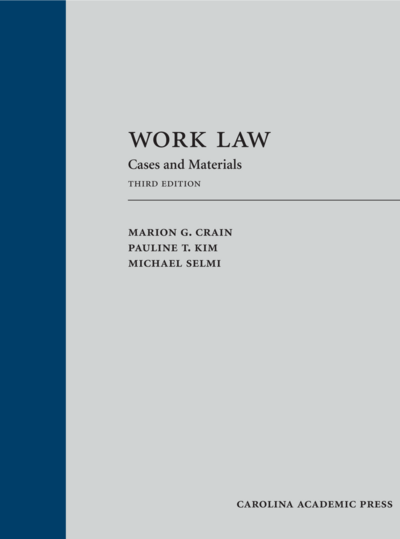This book has been replaced by a newer edition:
Work Law: Cases and Materials, Fourth Edition
2020, 1000 pp, casebound, ISBN 978-1-5310-1326-4
$215.00
Teacher's Manual available
Work Law
Cases and Materials
Third Edition
by Marion G. Crain, Pauline T. Kim, Michael Selmi
2015
Tags: Labor/Employment Law
Teacher's Manual available
1126 pp $189.00
ISBN 978-1-63281-538-5
eISBN 978-1-63281-539-2
To view or download the 2018 Supplement to this book, click here.
The law of work has evolved as a patchwork of legal interventions in the labor market, sometimes by statute, and sometimes through the common law of judicial decisions. Most law school curricula divide the law of work into three topical areas—Labor Law, Employment Law, and Employment Discrimination—and offer separate courses in each area. Labor law in the United States is understood to encompass the study of the National Labor Relations Act, the law governing union organizing and collective bargaining. It is the law of collective rights at work. Employment law refers to the statutes and common law governing individual rights at work. It ranges from minimum standards legislation to judicially created doctrines based in tort and contract law. Employment discrimination law deals with the statutes and interpretative case law advancing the antidiscrimination norm in the workplace. These statutes address the problem of status discrimination at work (e.g., discrimination on the basis of race, sex, national origin, ethnicity, religion, disability, or sexual orientation).
The book adverts to Labor Law principles at a number of points throughout the book, but at a policy level rather than a doctrinal level, as a way of introducing and evaluating an alternative model of employee representation; the book does not assume any knowledge of Labor Law on the part of teacher or student and makes no effort to provide a satisfactory substitute for a Labor Law text. The book offers some detail in the law of Employment Discrimination but does so primarily with an eye toward surveying the field and assessing antidiscrimination regulation as a response to an increasingly diverse workforce, rather than providing an in-depth study of Employment Discrimination principles.
The third edition of Work Law: Cases and Materials incorporates new developments in a variety of areas.
- New materials on defining the boundaries of the employment relationship, including O ' Connor v. Davison, interns as employees, and problems designed to encourage students to work through issues on what should count as work and who should be treated as workers for work law purposes (e.g., interns, prisoners, scholar-athletes, and cheerleaders for professional sports teams);
- Coverage of cases addressing the status of interns as employees covered by the Fair Labor Standards Act, including Glatt v. Fox Searchlight and Wang v. Hearst Corporation;
- Expanded materials on the Dodd-Frank Act and Sarbanes-Oxley whistleblower legislation and doctrinal developments, including Lawson v. FMR;
- New materials on employee privacy, including Stengart v. Loving Care Agency and City of Ontario v. Quon and expanded materials on the Stored Communications Act;
- Expanded coverage of legal issues surrounding employee voice, including the NLRB's social media cases (Hispanics United and Karl Knauz Motors);
- Coverage of the Supreme Court's 'cat's paw' case, Straub v. Proctor Hospital;
- The new pattern or practice case on discrimination from the Supreme Court, Wal-Mart Stores v. Dukes;
- Expanded coverage of the Amendments to the ADA, including Weaving v. City of Hillsboro;
- Updated and expanded materials on overtime pay eligibility under the Fair Labor Standards Act, including Christopher v. SmithKline Beecham Corporation;
- Updated materials on occupational safety and health, including SeaWorld v. Perez; and
- Updated materials on arbitration of employment disputes, including cases applying the Court's treatment of pre-dispute waivers of class claim.



